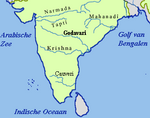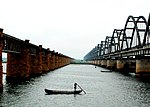
The Godavari River has its catchment area in seven states of India: Maharashtra, Telangana, Chhattisgarh, Madhya Pradesh, Andhra Pradesh, Karnataka and Odisha. The number of dams constructed in Godavari basin is the highest among all the river basins in India. Nearly 350 major and medium dams and barrages had been constructed in the river basin by the year 2012.

Nagarjuna Sagar Dam is a masonry dam across the Krishna river at Nagarjuna Sagar which straddles the border between Guntur district, Andhra Pradesh and Nalgonda district, Telangana. Constructed between 1955 and 1967, the dam created a water reservoir with gross storage capacity of 11.472 billion cubic metres. The dam is 590 feet (180 m) tall from its deepest foundation and 0.99 miles (1.6 km) long with 26 flood gates which are 42 feet (13 m) wide and 45 feet (14 m) tall.

The Srisailam Dam is constructed across the Krishna River in Kurnool district, Andhra Pradesh near Srisailam temple town and is the 2nd largest capacity working hydroelectric station in the country.
The J. Chokka Rao Devadula lift irrigation scheme is a lift irrigation scheme in India. It is the second biggest of its kind in Asia. Devadula is the place in Warangal District, Telangana, where the scheme's intake well is located.
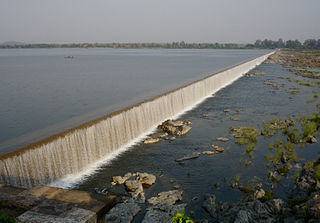
Dummugudem is a village in Bhadradri Kothagudem district of the Indian state of Telangana. It is located in Dummugudem mandal of Bhadrachalam revenue division.
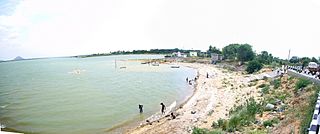
Paleru is a tributary of the Krishna river which joins the main river near Mukteswarapuram in Jaggayyapeta mandal of Krishna district in Andhra Pradesh. During the Nizam rule, a reservoir was constructed on the river at Paleru town, Kusumanchi. Hundreds of acres are irrigated with the help of this reservoir. Paleru reservoir acts as a balancing reservoir to the Nagarjunasagar left canal.

Polavaram Project, is an under construction multi-purpose National project on the Godavari River in the West Godavari District and East Godavari District in Andhra Pradesh. The project has been accorded national project status by the Union Government of India and will be the last to be accorded the status. It's reservoir back water spreads up to the Dummugudem Anicut i.e. approx 150 km back form Polavaram Spillway on main river side and approx 115 km in Sabari River side.It is located 40 km to the upstream of Sir Arthur Cotton Barrage in Rajamahendravaram City. Thus back water spreads into parts of Chhattisgarh and Odisha States. It gives major boost to tourism sector in Godavari Districts as the reservoir covers the famous Papikonda National Park, Polavaram Hydro electric project(HEP) and National waterway 4 are in under construction at left side of the river.
Pranahita Chevella lift irrigation scheme is a lift irrigation scheme to harness the water of Pranhita tributary of Godavari river for use in the Telangana state of India. The river water diversion barrage across the Pranahita river is located at Thammidihatti village in Komaram Bheem district of Telangana. This lift canal is an inter river basin transfer link by feeding Godavari river water to Krishna river basin. The chief ministers of Telangana and Maharashtra states reached an agreement in 2016 to limit the full reservoir level (FRL) of the barrage at 148 m msl with 1.85 tmcft storage capacity. In the year 2016, this project is divided into two parts. The scheme with diversion canal from the Thammmidihatti barrage to connect to existing Yellampalli reservoir across the Godavari river is presently called Pranahita barrage lift irrigation project. This scheme is confined to providing irrigation facility to nearly 2,00,000 acres in Adilabad district using 44 tmcft water.

Pulichintala Project is a multipurpose project serving irrigation needs, hydro power generation and flood control. It is a crucial irrigation facility for farmers of four coastal districts of West Godavari, Krishna, Guntur and Prakasam where irrigation facility for 13 lakh acres. It has 24 gates in all with balancing reservoir with a capacity of 46 tmcft at 175 feet (53 m) MSL full reservoir level (FRL). The project started impounding the water in August 2014. The cost of the project has exceeded Rs.1850 crores.
Alimineti Madhava Reddy Project earlier known as Srisailam Left Bank Canal is an irrigation project located in Nalgonda district in Telangana, India.

Inchampalli Project was a multi-purpose project proposed in 2008, with hydro electricity generation, irrigation, flood control, etc. benefits on the River Godavari in India. This project is proposed as joint project of Telangana, Maharashtra and Chhattisgarh states.

The Tungabhadra Dam also known as Pampa Sagar is constructed across the Tungabhadra River, a tributary of the Krishna River. The dam is in Hosapete, Ballari district of Karnataka. It is a multipurpose dam serving irrigation, electricity generation, flood control, etc. This is a joint project of erstwhile Hyderabad state and erstwhile Madras Presidency when the construction was started; later it became a joint project of Karnataka and Andhra Pradesh after its completion in 1953. The main architect of the dam was Vepa Krishnamurthy, ISE, Engineer-in-Chief, Hyderabad State, after Police Action, an engineer from Madras PWD. There is a dispute between Andhra Pradesh,Telangana and Karnataka for the water of Tungabhadra reservoir. He argued for the stability and longevity of the Dam, built of Surki Mortar viz a combination of mud and limestone. It's the only non-cement and concrete dam in the country and has withstood the test of time for over 70 years, and may well cross many more decades. He envisioned it as being built with a large contingent of manual labour, as best suited to Indian labouravailabilty and employment. The main contractor for the dam was Venkat Reddy Mulamalla, from Konour village, Mahabubnagar, Hyderabad state.
Handri-Neeva Sujala Sravanthi project is the longest water canal project in Rayalaseema, India. The project is conceived to provide irrigation facilities and reliable drinking water supply, by drawing flood waters from the Srisailam reservoir. The first phase commences at Malyala, and irrigates six lakh acres in four districts of Rayalaseema, while the second phase is set to provide irrigation facilities for and drinking water to Chittoor district. This canal links the Handri River, Penna River, Chitravathi River, Papagni River, Mandavya River, Bahuda River, Cheyyeru River, Gargeya River, Vedavati River, Palar River and many other rivers in the Rayalaseema region. The canal is spread across Kurnool, Ananthapur, Kadapa and Chittoor districts. The canal feeds several reservoirs and water tanks in the region. In order to achieve full requirements of drinking and irrigation water of the region, more than 50 Tmcft water is required.
Kandeleru Dam is an irrigation project built on the Kandaleru River in Rapur Mandal, Nellore district in the Indian state of Andhra Pradesh. The project is part of the Telugu Ganga project that supplies drinking water to Chennai city from the Srisailam reservoir on Krishna River. Kandaleru reservoir is mainly fed by a link canal from Somasila Dam. The Telugu Ganga project provides irrigation.

Kurnool Cuddappah Canal popularly known as K.C. Canal is an irrigation canal located in Kurnool and Cuddapah districts in Andhra Pradesh, India.

Nagarjuna Sagar tail pond is a multipurpose reservoir located 21 km downstream from the Nagarjuna Sagar Dam across the Krishna River near Satrasala in Nalgonda district, India. Its gross water storage capacity is 6 Tmcft. The reservoir water spread area extends up to the toe of the Nagarjuna Sagar dam. The project was completed by July 2014.

Taliperu Project also known as Taliperu Reservoir is a medium irrigation project constructed across the Taliperu River, a tributary of Godavari River, located at Cherla Village and Mandal, Khammam District, Telangana. This project utilizes about 5.0 TMC of water and creates 24,500 acres (9,900 ha) of Ayacut in both Cherla and Dummugudem Mandals, Khammam District.
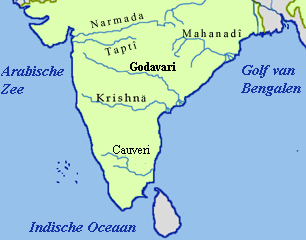
Taliperu is a river in the Godavari system originating in the Bijapur District of Chhattisgarh. It is a left-bank tributary of Godavari River, draining into it through a confluence located near Cherla in the Khammam District in Telangana.

Pattiseema Lift Irrigation Project is a river interlinking project which connects Godavari River to Krishna River. This project has thereby become the first of such irrigation type projects in the country to be completed in time without any budget enhancements. It also holds a record in Limca Book of Records. .The project was Inaugurated by the Chief Minister of Andhra Pradesh Nara Chandrababu Naidu on March 2016 while the project was completed in one year record of time.
Vykuntapuram Barrage is an Indian barrage and water storage project. It is under construction on Krishna River 23 kilometers upstream of existing Prakasam Barrage with FRL 25M. It is designed to store 10 TMC of flood water coming from the Vyra and Munneru rivers. The backwater of this dam will extend beyond Pokkunuru to the toe of Pulichintala dam. Andhra Pradesh Chief Minister Nara chandrababu Naidu laid the foundation stone for this project on 13 February 2019.














